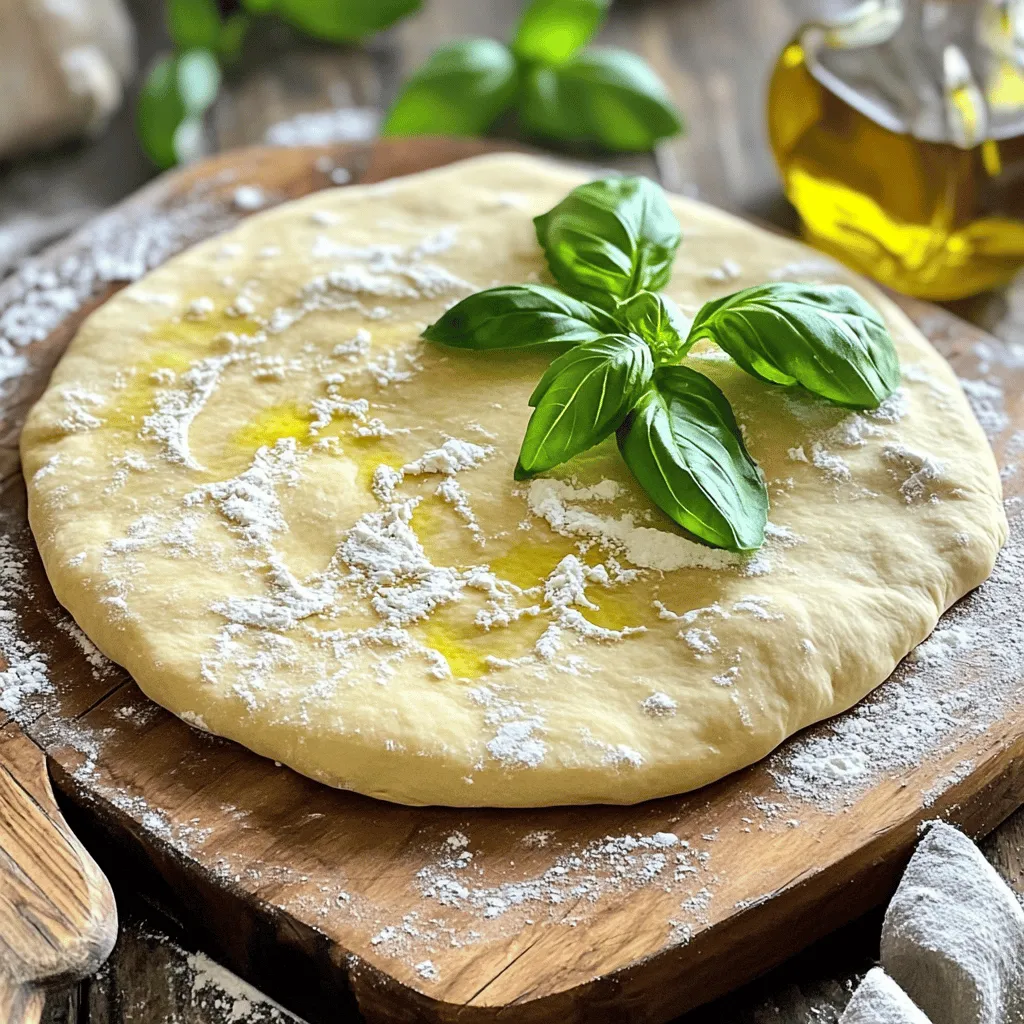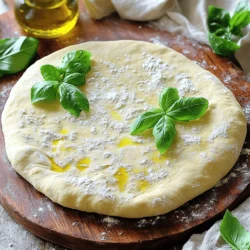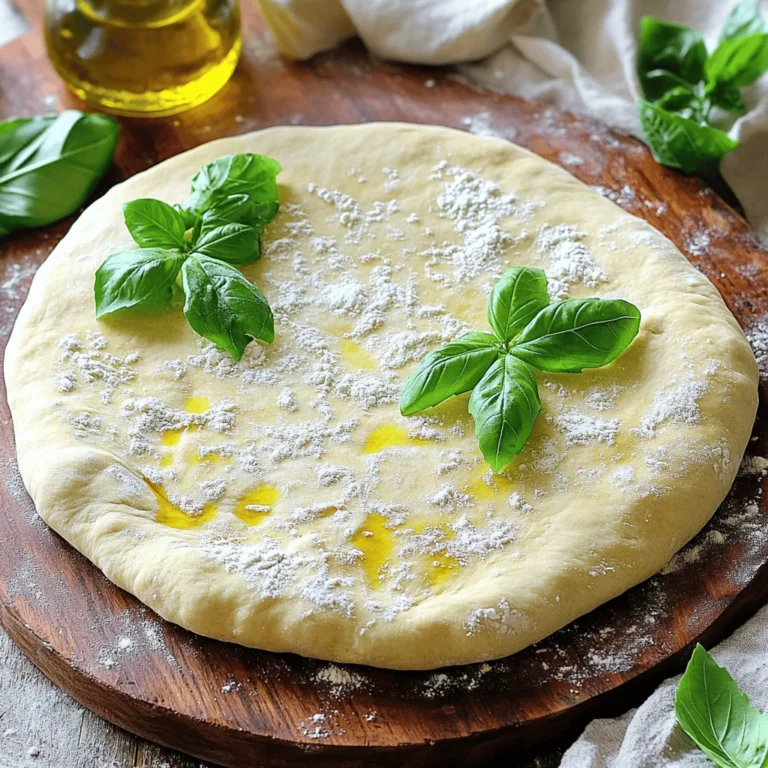Making homemade pizza dough is fun and easy! With just a few ingredients, you can create a delicious crust that suits your taste. Forget the store-bought varieties; I’ll show you how to craft your own from scratch. In this article, I’ll share a simple and tasty recipe, along with tips to make the best dough for your next pizza night. Let’s get started on this mouthwatering journey!
Ingredients
Detailed Ingredients List
– 4 cups all-purpose flour (plus extra for dusting)
– 1 packet (2 ¼ teaspoons) active dry yeast
– 1 ½ cups warm water (110°F/43°C)
– 2 tablespoons olive oil
– 1 tablespoon sugar
– 1 teaspoon salt
Importance of Ingredient Quality
Using fresh yeast gives your dough a better rise. Old yeast might not activate well, leading to flat crusts. Always check the date on the packet. Fresh yeast helps your pizza dough reach its full potential.
Choosing the right flour is key, too. All-purpose flour is great for most pizzas. It gives a nice balance of chewiness and crunch. If you want a softer dough, use bread flour. It has more protein, which helps with texture.
Optional Add-ins
You can add herbs to your dough for extra flavor. Oregano, basil, or garlic powder can make a big difference. Just mix in a teaspoon when you add the flour.
If you want gluten-free options, try almond flour or gluten-free blends. These can change the texture, so you may need to adjust your water. Experiment to find what you like best.
Step-by-Step Instructions
Preparing the Yeast Mixture
To start, you need to combine warm water and sugar. Use 1 ½ cups of warm water, about 110°F (43°C). This temperature is key; too hot can kill the yeast. Add 1 tablespoon of sugar to the water. This sugar feeds the yeast and helps it grow.
Next, sprinkle 1 packet (2 ¼ teaspoons) of active dry yeast on top of the water. Let it sit for about 5-10 minutes. You will see bubbles forming on top. This means the yeast is active and ready to use. If you don’t see bubbles, try again with fresh yeast.
Mixing and Kneading Dough
In a large bowl, combine 4 cups of all-purpose flour and 1 teaspoon of salt. Make a well in the center. Pour the frothy yeast mixture and 2 tablespoons of olive oil into the well.
Using a wooden spoon, mix until a dough begins to form. As the dough comes together, transfer it to a floured surface. Knead the dough for 8-10 minutes. You want it to be smooth and elastic. If the dough is sticky, add a bit more flour.
Rising and Shaping the Dough
Once kneaded, shape the dough into a ball. Place it in a lightly oiled bowl, then cover it with a damp cloth or plastic wrap. Let it rise in a warm place for 1-1.5 hours. This rising time is important for a fluffy crust.
After it has doubled in size, punch the dough down to release the air. Turn it out onto a floured surface. Divide it into 2-3 equal pieces based on your crust thickness preference.
Use a rolling pin or your hands to roll each piece into your desired shape and thickness. This is where you can get creative! Now, your dough is ready for toppings.
Tips & Tricks
Achieving the Perfect Dough Texture
To know if your dough is well-kneaded, look for a smooth surface. It should spring back when you poke it. If it feels sticky, knead a bit longer or add more flour. Different flours absorb water differently. If it’s humid, you might need less water. In dry weather, you may need a little more. Adjust as needed to get that perfect texture.
Time-Saving Tips
You can make the dough in advance. After kneading, let it rise and then punch it down. Store it in the fridge for up to three days. This way, you can have fresh pizza dough ready when you want it. You can also freeze it. Wrap it tightly in plastic wrap, and it can last for three months. Just remember to thaw it overnight in the fridge before using.
Using Pizza Stones vs. Baking Sheets
Pizza stones hold heat well and give a crispy crust. Preheat your stone in the oven for at least 30 minutes. Use a baking sheet if you don’t have a stone. It’s easier for beginners. Just adjust the baking time. The crust may take a bit longer to bake on a sheet. No matter which method you choose, aim for that hot temperature for the best results.

Variations
Different Pizza Styles
You can choose from many pizza styles. Thin crust is crispy and light. It cooks fast and is great for classic toppings. Thick crust is soft and fluffy inside. It holds more sauce and toppings. Chicago-style deep dish has a tall, deep crust. It’s like a pizza pie, baked in a pan. This style has lots of cheese and sauce. It takes longer to cook but is very filling.
Flavored Dough Options
Adding flavors to your dough is fun. You can mix in garlic powder or fresh herbs. Basil, oregano, or rosemary work great. This gives your crust a tasty boost. You can also try whole wheat flour. It adds fiber and a nutty taste. Other flours can change the texture, too. Gluten-free flours are good for those with allergies. Just make sure to adjust the liquid to get the right dough.
Using Dough for Other Dishes
Pizza dough is not just for pizza! You can use it to make calzones. Just fold the dough over your favorite fillings. It’s easy to hold and eat. Breadsticks are another great option. Roll out the dough and cut it into strips. Bake them until golden for a tasty snack. Pizza pinwheels are fun and easy, too. Spread sauce and toppings, roll it up, and slice. Bake those slices for a delicious treat. Try these ideas with your homemade pizza dough for variety!
Storage Information
How to Store Leftover Dough
To keep your leftover pizza dough fresh, use an airtight container. This prevents air from drying it out. If you plan to use the dough soon, store it in the fridge. Pizza dough can stay fresh in the fridge for about 3 days. For longer storage, freezing is best. It can last for up to 3 months in the freezer.
Best Practices for Freezing Dough
When freezing dough, wrap it well. Use plastic wrap and then place it in a freezer bag. This prevents freezer burn. To thaw, move the dough to the fridge overnight. If you need it fast, you can let it sit at room temperature for about 1 hour. Just make sure it softens before you shape it.
Shelf Life of Pizza Dough
Pizza dough can be stored for a few days in the fridge. If you freeze it, you can keep it for about 3 months. Always check for signs of spoilage. If it smells sour or has a hard crust, it’s best to toss it out. Fresh dough should feel soft and stretchy. For the best taste and texture, use it sooner rather than later.
FAQs
How long does homemade pizza dough last in the fridge?
Homemade pizza dough lasts about 3 to 5 days in the fridge. Store it in an airtight container. This keeps it fresh and prevents it from drying out. If you plan to use it later, check for any off smells or changes in texture.
Can I make the dough without yeast?
Yes, you can make pizza dough without yeast. Use baking powder or baking soda as a leavening agent. This will give you a different texture, but it can still taste great. Just mix the dry ingredients and add liquid as you would with yeast.
What is the best way to roll out pizza dough?
To roll out pizza dough, start on a floured surface. Use a rolling pin for even thickness. If you prefer, use your hands to stretch the dough. Aim for about ¼-inch thick for a good crust. Rotate the dough as you roll to keep it round.
Can I double the recipe?
You can double the recipe easily! Just double each ingredient. Make sure your mixing bowl is large enough to handle the extra dough. Let the dough rise as usual. This way, you can make more pizzas to share with friends.
What are some common mistakes with pizza dough?
Common mistakes include using cold water or not kneading enough. Cold water can slow yeast activation. Not kneading enough leads to a tough crust. If your dough is too sticky, add a bit more flour. If it’s too dry, add a splash of water.
Making homemade pizza dough is simple and fun. You learned about essential ingredients and their quality. I shared techniques for mixing, kneading, and rising the dough. You also found tips to save time and variations for flavor. Lastly, you now know how to store your dough properly.
In your journey to pizza perfection, remember to adjust for your needs. Enjoy the process and make it your own!


